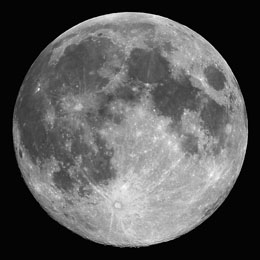It is no surprise that the
Moon is on the list
for naked eye observing. It is the only celestial
object (except our
Sun) that can be seen in the
daylight (however there have been
comets in the past
that were bright and large enough to also be seen in
the daylight - and
Venus can also be visible if you
know exactly where to look).
 |
The
Moon and its prominent features are
easily viewable with the eye. The full
Moon does look very large, but you will find that
the
Moon will be covered by your finger.
Your finger will measure about 1 degree
while the full
Moon is only 1/2º.
Click on the image to see a larger, rollover
image with labels of the prominent features. |
In addition to observing the features of the
Moon, the phases of the
Moon can also be observed.
See the section on the
Moon for more details.
Try this neat trick: a full moon near the horizon appears much larger than when the full moon is high in the sky. Is the disk of the moon larger at the horizon? The answer will surprise you - the moon's apparent diameter is ALWAYS 1/2º, both at the horizon and at zenith. This website expands on this illusion.
|

